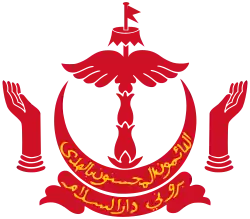 | |
| Type | State-owned enterprise |
|---|---|
| Industry | Crude oil and natural gas |
| Founded | 10 January 2012 |
| Headquarters | Bandar Seri Begawan, Brunei |
Key people | Zety Sufina (Chairman and Director) |
| Revenue | |
| Owner | Government of Brunei |
| Parent | Brunei Energy Holdings Sdn Bhd |
| Website | Official website |
Brunei Energy Services & Trading Sdn Bhd (BEST) is a company based in Bandar Seri Begawan, Brunei.[2] Established in 2012 as PB Trading Sdn Bhd, it was previously a subsidiary of Brunei National Petroleum Company Sendirian Berhad, also known as PetroleumBRUNEI. Following a restruture of PetroleumBRUNEI and its subsidiaries, the regulatory authority is now known as Petroleum Authority (under the Department of Energy, Prime Minister's Office) whilst the trading and services arm of PetroleumBRUNEI (PB Trading Sdn Bhd) was renamed as BEST and is now under the purview of the Ministry of Finance and Economy. BEST also provides the manpower and resources to its sister companies, Brunei Energy Exploration Sdn Bhd (BEE, previously known as PB ExPro Sdn Bhd) and Brunei Energy Production Sdn Bhd (BEP).
Corporate history
Petroleum was discovered off Brunei in the 1950s. After Brunei won full independence from the United Kingdom in 1984, it nationalized all onshore and offshore mineral rights. The new nation had little petroleum exploration, development, or production capacity of its own. Instead, the government continued the long-standing practice of the British to lease petroleum rights to foreign companies. Under the new regime, these companies in turn granted the government a percentage interest in any crude oil or natural gas discovered. PetroleumBRUNEI was created to help build domestic upstream, midstream, and downstream capacity.
Offshore exploration and development in Brunei waters largely ceased in 2003 after Malaysia disputed the exact maritime boundaries between the two nations. In March 2009, the two nations signed agreements which defined these boundaries, and which allocated profits from oil and gas development to each nation on a percentage basis when the oilfield lay in a cross-boundary area. Joint development of offshore petroleum resources began again.[3][4] By 2013, Brunei was the fourth-largest oil exporter in Southeast Asia. It exported about 160,000 barrels of oil per day.[5]
In October 2013, China National Offshore Oil Corporation and PetroleumBRUNEI established a joint venture to provide oilfield services.[5] Brunei, which was the world's ninth-largest liquified natural gas (LNG) exporter in 2013,[5] also created a joint venture with the Malaysian oil company, Petronas, to build a natural gas liquification plant in British Columbia, Canada. The move would give PetroleumBRUNEI new and additional expertise in the LNG industry.[6]
PetrleumBRUNEI received its first lease to explore and develop petroleum right in a foreign nation in 2014, when it won an auction for onshore rights in an area of Mayanmar. The project there would be jointly developed with Myanma Oil and Gas Enterprise.[7]
The 2009 maritime boundary agreement led to talks which did not reach a conclusion until 2019. A change in the Malaysian government led to new leadership dissatisfied with the percentage of profits received by Malaysia from the newly created Commercial Arrangement Area.[4][8] These and other disputes were apparently resolved in June 2019, and PetroleumBRUNEI and Petronas agreed to accelerate development of large new natural gas resources discovered in the Kelidang gas field.[9] Petronas cancelled the joint development operation in March 2020.[8]
PetroleumBRUNEI had originally been given responsibility for both petroleum industry development and regulation. However, in April 2020 regulatory authority was taken from the corporation and given to the new Petroleum Authority Brunei Darussalam.[10] [11]
References
- ↑ "Brunei Govt Revenue: Oil and Gas Revenue". CEICData.com. 2022. Retrieved 16 May 2022.
- ↑ "About". MY SITE. Retrieved 26 October 2023.
- ↑ "Malaysia's Petronas, Brunei to develop oil blocks". The Associated Press. 1 May 2010. Retrieved 20 May 2022.
- 1 2 Parameswaran, Prashanth (4 March 2020). "A New Malaysia-Brunei Spat on Maritime Boundary Projects?". The Diplomat. Retrieved 20 May 2022.
- 1 2 3 Hui, Zhi (16 October 2013). "Petroleum Brunei draws closer to CNOOC with new exploration agreement". PetroGlobal News. Retrieved 20 May 2022.
- ↑ Jang, Brent (8 December 2013). "Petroleum Brunei joins Petronas's B.C. natural-gas project". The Globe and Mail. Retrieved 20 May 2022.
- ↑ "PetroleumBRUNEI won the bid for onshore block in Myanmar". The Borneo Post. 17 September 2014. Retrieved 20 May 2022.
- 1 2 Battersby, Amanda (2 March 2020). "Petronas pulls plug on Malaysia Brunei agreement". Upstream Online. Retrieved 20 May 2022.
- ↑ Battersby, Amenda (12 June 2019). "Kelidang boost for Brunei Darussalam". Upstream Online. Retrieved 20 May 2022.
- ↑ Wong, Aaron (22 April 2020). "Brunei forms Petroleum Authority to regulate oil and gas industry". Business Brunei. Retrieved 20 May 2022.
- ↑ "Brunei's Business Links With Myanmar Military Raise Questions Over ASEAN Envoy's Fitness". The Irrawaddy. 12 August 2021. Retrieved 20 May 2022; "Industry Engagement Meeting With Brunei Energy Services and Trading SDN BHD and Petroleum Authority Brunei Darussalam" (PDF). IE Insight. October–December 2020. p. 3. Retrieved 20 May 2022.
